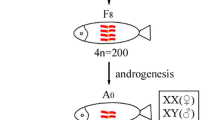Abstract
Bisexual fertile diploid androgenetic individuals (A0) (2n=100) were formed by androgenesis. In this way, the diploid spermatozoa from male allotetraploid hybrids (AT) (4n=200) of red crucian carp (Carassius auratus red var.) (♀) × common carp (Cyprinus carpio L.) (♂) were used to fertilize the UV-treated haploid eggs of goldfish (Carassius auratus), and living androgenetic diploid fish were developed. The A0 became sexually mature at the age of 2 years, and they fertilized with each other to form their offspring (A1). In this study, we observed the chromosomal number, gonadal structure and appearance of A1 fish. The results are as follows: (1) In A1, there were 85% tetraploids (A1-4n), 10% triploids (A1-3n) and 5% diploids (A1-2n), suggesting that diploid A0 could produce diploid gametes. It was concluded that the formation of diploid gametes generated from diploid A0 was probably related to the mechanism of pre-meiotic endoreduplication. (2) Among A1, only A1-4n possessed normal ovaries and testes. The mature males of A1-4n produced white semen. Under the electron microscope, the head of diploid sperm generated by A1-4n was bigger than that of haploid sperm generated by red crucian carp. In the testes of the A1-4n, there were many mature normal spermatozoa with a head bearing plasma membrane and a tail having the typical structure of “9+2” microtubules. Between the head and the tail, there were some mitochondria. The ovaries of A1-4n developed well and mainly contained II, III and IV-stage oocytes. The IV-stage oocytes were surrounded by inner and outer follicular cells. The micropyle was observed on the oolemma of follicular cells. There were abundant yolks and plenty of endoplasmic reticulum in the cytoplasm of IV-stage oocytes. Because A1-2n and A1-3n were distant crossing diploid hybrids and triploid hybrids respectively, they possessed abnormal gonads, and no mature semen and eggs were observed. (3) Compared with allotetraploids, the A1-4n fish not only had advantages such as fast growth rate and strong resistibility but also showed some new good performances such as high ratio of body width to body length, smaller heads and shorter tails. These results indicated that androgenesis could produce bisexual fertile tetraploids and improve the shape of allotetraploid hybrids as well, which will be of great significance in both the cell genetics research and fish breeding.
Similar content being viewed by others
References
Liu S J, Liu Y, Zhou G J, et al. The formation of tetraploid stocks of red crucian carp × common carp hybrids as an effect of interspecific hybridization. Aquaculture, 2001, 192: 171–186, 10.1016/S0044-8486(00)00451-8
Liu S J, Sun Y D, Zhang C, et al. Production of gynogenetic progeny from allotetraploids hybrids red crucian carp × common carp. Aquaculture, 2004, 236: 193–200
Liu S J, Duan W, Tao M, et al. Establishment of the diploid gynogenetic hybrid clonal line of red crucian carp × common carp. Sci China Ser C-Life Sci, 2007, 50(2): 186–193
Sun Y D, Zhang C, Liu S J, et al. Induced interspecific androgenesis using diploid sperm from allotetraploid common carp × red crucian carp hybrids. Aquaculture, 2007, 264: 47–53
Li J Z, Zhang X J, Liu S J, et al. Allotetraploid of red crucian carp (♀) × common carp (♂). J Nat Sci Hunan Norm Univ, 2001, 24(2): 64–66
Sun Y D, Liu S J, Zhang C, et al. The chromosome number and gonalal structure of F9–F11 allotetraploid crucian-carp. Acta Genet Sin (in Chinese with English abstract), 2003, 30(5): 414–418
Shen J M, Liu S J, Sun Y D, et al. A new type of triploid crucian crap-red crucian carp (♀) × allotetraploid (♂). Prog Nat Sci, 2006, 16(12): 1348–1352
Liu S J, Sun Y D, Zhou G J, et al. The ultrastructure of the mature testes and erythrocytes in allotetraploids of red crucian carp × common carp. Prog Nat Sci (in Chinese with English abstract), 2003, 13(2): 194–197
Liu S J, Sun Y D, Luo K K et al. Evidence of different ploidy eggs produced by diploid F2 hybrids of Carassius auratus(♀) × Cyprinus carpio(♂). Acta Genet Sin, 2006, 33(4): 304–311
Liu S J, Qin Q B, Xiao J, et al. The formation of the polyploid hybrids from different subfamily fish crossings and its evolutionary significance. Genetics, 2007, 176: 1023–1034
Li S F. Genetical Characterization of Major Freshwater Culture Fishes in China. Shanghai: Shanghai Scientific and Technical Publishers, 1998. 189–193
Zhao Z S, Wu Q J, Gao G G. Progress on research of fish androgenesis. Hereditas (Beijing), 2000, 22(2): 109–113
Wu Q J, Ye Y Z, Dong X H. Two unisexual artificial polyploid clones constructed by genome addition of common carp (Cyprinus carp) and crucian carp (Carassius auratus). Sci China Ser C-Life Sci, 2003, 46: 595–604
Author information
Authors and Affiliations
Corresponding author
Additional information
These authors contributed equally to this work
Supported by the National Natural Science Foundation of China (Grant Nos. 30330480 and 30571444), the Doctoral Station of University of the Education Ministry of China (Grant No.200405422001), the Agriculture Technological Production Foundation of the Science and Technology Ministry of China (Grant No. 2005380) and Important Solution Project of Hunan Province (Grant No. 2006NK2008)
Rights and permissions
About this article
Cite this article
Duan, W., Qin, Q., Chen, S. et al. The formation of improved tetraploid population of red crucian carp × common carp hybrids by androgenesis. SCI CHINA SER C 50, 753–761 (2007). https://doi.org/10.1007/s11427-007-0090-5
Received:
Accepted:
Published:
Issue Date:
DOI: https://doi.org/10.1007/s11427-007-0090-5



